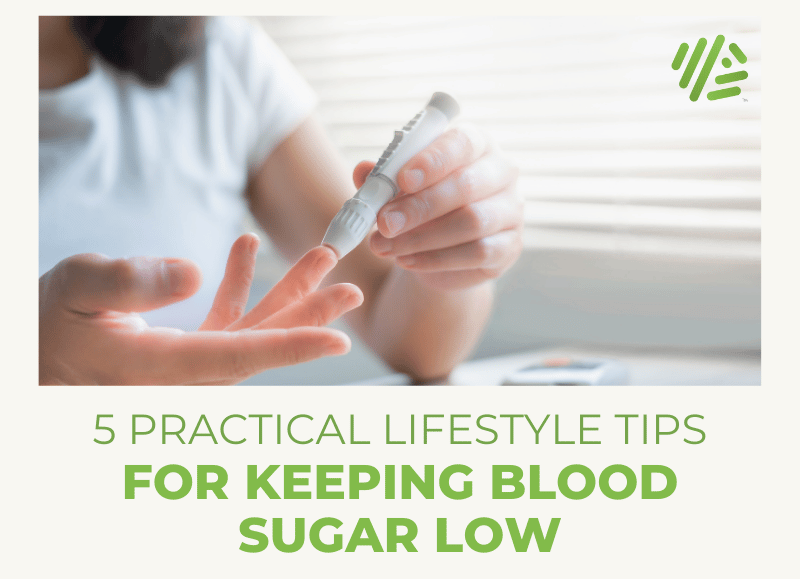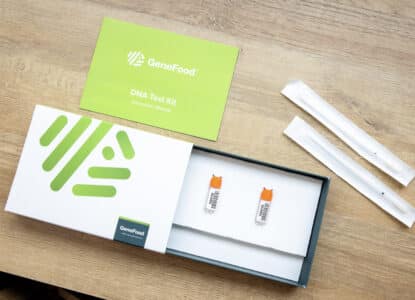Keeping Blood Sugar Low: 5 Lifestyle Changes to Consider

When we eat carbohydrates, and sometimes even when we eat protein (carnivore dieters please take note), the food is broken down into a simple sugar called glucose, which every cell in the body can use for energy.
It is this glucose “carb fuel” reaching the blood stream that is responsible for “spikes in blood sugar.” 1
The glucose circulating in the bloodstream is recognized by the pancreas which in turn pumps out a hormone called insulin whose job it is to get that glucose into our cells where we can use it for energy. 2
When we take in more energy than the body can use, or store as glycogen, the result is very often high triglycerides as the body converts the sugar into fat we can store for a rainy day.
Defining insulin sensitivity
Those of us who do a good job getting glucose into the cells quickly and efficiently are known as “insulin sensitive.” Insulin sensitive people use carbohydrates quickly and efficiently, so they don’t suffer from elevated blood sugar. Insulin is an important hormone, but the body works better when we use less of it, not more.
By contrast, those who eat carbohydrate (and sugar) and are “insulin resistant” can see immediate and prolonged spikes in both insulin and glucose. These people are called insulin resistant because their body’s have to pump more insulin to get glucose into cells. The more insulin they pump and the more glucose stays elevated, the greater the inflammatory reaction in the body. 3
The immune system knows the glucose you eat belongs in the cells and not in the blood. As a result, it send out cytokines, the weaponry of the immune system, to attack the extra glucose when it gets too high. This applies to both chronic elevation of blood sugar as well as immediate spikes after meals in what is known as the “post prandial” period.
This immune response to elevated blood sugar is why high blood sugar is inflammatory and why you want to keep blood sugar in check.
Practical tips for keeping blood sugar low
What are some practical tips for keeping blood sugar in check, both long-term and immediately after a meal in this all-important “post-prandial” period?
In other words, how can we become insulin sensitive glucose burning machines?
#1. Lift weights
You don’t have to be a meat head or a cross fit bro to benefit from training with weights. To the contrary, I have recently gotten back into lifting as a strategy for staying more insulin sensitive.
How does this work?
The liver and muscle tissue are storage centers for glucose in the form of glycogen, but they can only take on so much. Exercises like lifting weights cause the muscle to spend glycogen, which in turn allows the same muscle to mop up more glucose the next time you eat a meal.
The process of lifting gives you the ability to get the glucose you eat into the cell where it belongs, hence lowering blood sugar. 4
#2. Fasted run / workout prior to breakfast
Another line of studies tends to show that working out in a fasted state, prior to breakfast, increases the body’s ability to burn fat and makes us more insulin sensitive. My current pre-breakfast regimen is a few sprints on the treadmill followed by four different weights exercises isolating a body group (legs one day, chest another).
In this study, healthy young men were gorged with a high fat diet at 30% above normal caloric intake. All of the subjects became insulin resistant expect the group who worked out before breakfast.5
Another study found that as little as 7.5 – 20 minutes of high intensity interval training prior to breakfast improved blood glucose levels for as long as 3 days after the workouts.6
#3. Resistant starch
When we eat pancakes, the refined grains are rapidly converted to sugar and the sugar gets into the blood direct from the small intestine. However, if our carbohydrate sources can make their way intact to the large intestine, as happens when we eat high fiber foods, that’s where all the magic happens. There we get fermentation and production of the short chain fatty acids that give us energy and protect the lining of the gut. Resistant starch is a type of carbohydrate that is not easily converted to glucose. As such, it survives the small intestine intact where it ferments in the large intestine. Due to the fact that they don’t easily break down into sugar, foods rich in resistant starch like green bananas, beans and oats are thought to help regulate blood sugar spikes and biomarkers like HbA1c.
We can even increase the resistant starch in foods like potatoes and white rice by allowing them to cool for several hours after cooking. Some blogs falsely claim that the process of then reheating these foods destroys the resistant starch, but this is not the case. Don’t trust me, take a look at this John’s Hopkins page on resistant starch which I found useful.
#4. Post meal stroll
Ben Greenfield discussed a study on his blog which showed that walking, as opposed to standing, in the post prandial period lowered the rise in triglycerides seen in non diabetic men after eating. The idea is that going on a short walk after dinner improves the metabolic response, a benefit that was not seen by walking prior to the meal.
Another study looked at blood glucose in response to exercise and found longer durations of movement after eating resulted in greater blood sugar control. One quote in particular stood out to me:
Exercise facilitates glucose transport without the presence of insulin, and more exercise contributes proportionately to a larger decrease.
Very well said. Exercise and movement helps get glucose in the cell without insulin. This is a “swing thought” I am using now whenever I eat, just a little bit of movement aids digestion and improves the glycemic response.
So, here we have a little bit of common sense – get out and take a walk after each meal, it helps regulate spikes in blood sugar in that tricky post prandial period.
#5. Supplements to lower blood sugar
The obvious one that comes to mind for me is berberine, as it has been shown to perform just as well as the popular diabetes drug metformin in some studies. As I discuss in my blog post on micro dosing berberine, metformin has become all the rage in anti-aging circles as there is some evidence it helps stave off cancer. But many in the integrative world, Ben Greenfield being a notable voice, are concerned about diminished performance with long term use of metformin. Berberine seems to be a good alternative since it performs on par with metformin and has also shown promise in lowering LDL-C and other lipid markers.
Another supplement to look at for keeping blood sugar in check is garlic. Vegan cardiologist Dr. Joel Kahn is a fan of garlic as a heart healthy supplement and a meta analysis of studies published in 2017 found that garlic does have efficacy in lowering blood sugar in type 2 diabetics. 7
Closing thoughts
While we do have an idea of the foods and situations that lead to elevated blood sugar, and the tips shared here are backed by scientific research, the best way to see for yourself what gets your blood sugar going is to experiment with a continuous blood glucose monitor.
Wearing a device like this will give you a personalized data set on when your blood sugar gets high and when it stays in a more manageable range.




Research has indicated that it is men who mainly benefit from exercise before meals, the reverse for women.